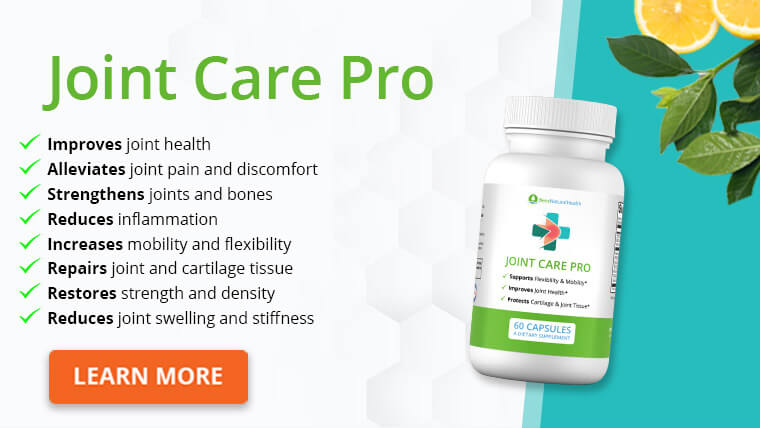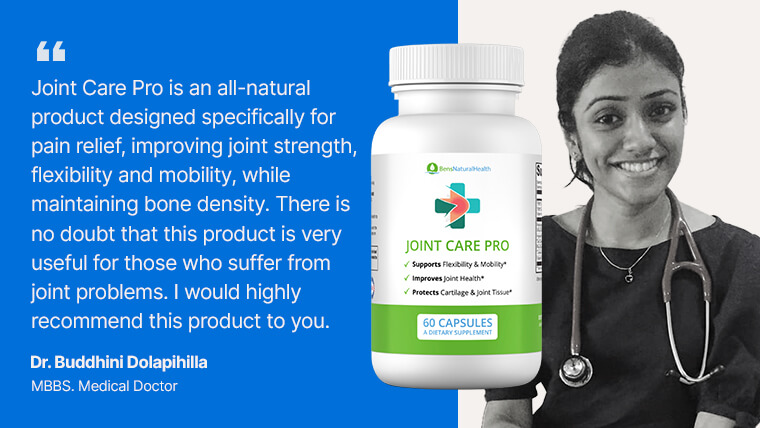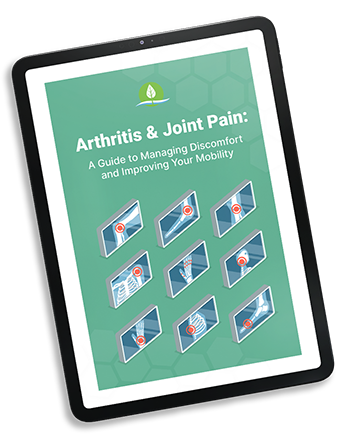Having aches and pains in your joints is a part of life.
You’ve probably dealt with some knee pain at some point, whether short-term or a more chronic issue.
The knee joints are involved in almost all physical activity, so having knee pain can be a big disruption in your daily lifestyle.
There are several different knee pain causes, which can manifest themselves in different ways.
Knowing the different knee pain causes, ways to prevent knee pain, and the various treatment options can help keep you pain-free and able to enjoy being active with good mobility.
Get Your FREE Arthritis Guide
- Learn how to naturally improve your arthritis symptoms
- Dietary recommendations, exercise guides, supplements, and lifestyle changes
- Developed exclusively by our medical doctor
Symptoms
Knee pain can manifest itself in different ways according to the location of the injury.
Some of the symptoms that can accompany knee pain include:
- Swelling and stiffness
- Redness and warmth to the touch
- Weakness or instability
- Popping or crunching noises
- Inability to fully straighten the knee
Causes
There are several knee pain causes, which can make diagnosing the exact problem difficult at times.
Your healthcare provider will likely take a detailed history of the onset of the pain, duration, and other aspects of your medical history to make an accurate diagnosis.
Imaging studies may also be ordered to make a definitive diagnosis.
The different knee pain causes can be grouped into three main categories: injuries, mechanical problems, and arthritis.
Injuries
One of the most apparent knee pain causes is an injury to the knee joint.
A knee injury can impact many parts of the knee, including the ligaments, tendons, and fluid-filled sacs called bursae surrounding the knee joint.
The injury can also affect the bones, ligaments, and cartilage of the actual knee joint.
Ligaments are a type of connective tissue that connects two bones, whereas tendons attach muscle to bone.
Common knee injuries
ACL tear
ACL stands for anterior cruciate ligament, one of four ligaments that help connect the shin bone to the thigh bone.
The ACL helps stabilize the knee and can be torn during activities that require quick changing of direction, such as basketball, soccer, football, tennis, and skiing.
Fractures
The bones of the knee, including the patella (kneecap), can be broken from trauma such as car accidents or falls.
Meniscus tear
This is one of the most common knee pain causes resulting from an injury.
The meniscus is a C-shaped piece of cartilage that helps cushion the thigh bone and shin bone.
Bursitis
The bursae are small, fluid-filled sacs that surround many joints, including the knee.
The bursae help cushion the knee joint, allowing the tendons and ligaments to glide smoothly during motion.
Knee bursitis symptoms tend to occur gradually over time (versus sudden knee pain), and can occur from prolonged kneeling on hard surfaces.
Patellar tendinitis
The patellar tendon connects the shin bone to the kneecap and works along with the thigh muscles (such as the quadriceps) to straighten the leg.
Patellar tendinitis occurs when the tendon is strained, usually as an overuse injury during sports.
It is referred to as “jumper’s knee” since jumping on hard surfaces is a risk factor, such as people who play volleyball on a gym floor.
Mechanical problems
Loose body
When bone or cartilage is injured or degrades, such as osteoporosis or a fracture, pieces can break off and float in the knee joint space.
The loose body may not cause any issues, but if it gets in the way of normal joint movement, it can begin to cause pain.
Iliotibial band syndrome
The iliotibial band (IT band) is a tough band of tissue running from the outside of the hip to the outside of the knee.
When this band becomes tight, such as long-distance runners, it can begin to rub against the outer part of the thigh bone and cause pain and inflammation.
Dislocated kneecap
The patella, or kneecap, is a small bone in front of the knee that protects the tendons and ligaments of the knee joint.
It also connects the muscles of the thigh to the muscles of the shin bone.
The kneecap can become dislocated from a sudden blow or change in direction, such as in sports or dancing.
When the kneecap is dislocated, the supporting tissues of the knee joint can become stretched and even torn.
A dislocated kneecap can result in severe knee pain as well as a “popping” sensation.
While painful, a dislocated kneecap is a common injury and will usually heal in around six weeks.

Altered movement
If you have pain in other parts of your body, such as your back, foot, or hip, it can put more stress on the knee joint and result in knee pain.
Arthritis
Many types of arthritis can impact the knee joint, such as:
Osteoarthritis
This is the most common type of arthritis, resulting from normal wear-and-tear on the joints, leading to inflammation and pain. Osteoarthritis is also referred to as “degenerative arthritis.”
Rheumatoid arthritis
This is an autoimmune disorder where the immune system mistakenly attacks healthy parts of the body, including joints like the knee.
With rheumatoid arthritis, symptoms can worsen and improve over the years, but they never completely disappear.
Risk factors
While knee pain can happen to anyone, certain risk factors can increase your risk.
Weight
If you’re considered overweight or obese for your height and weight, that weight can put extra strain on your knee joints, leading to knee pain.
Lack of strength or flexibility
If muscles supporting the knee are weak or inflexible, such as the quadriceps muscles or the hamstrings, it can cause the knee to take on more stress and cause knee pain.
Sports and occupations
Sports that put a lot of stress on the knee joint through frequent stopping and changing directions can increase the risk of knee injuries and knee pain.
Occupations that put stress on the knees, such as laying carpet or construction work, can also increase the risk.
Having a previous knee injury
If you’ve injured your knee in the past, the likelihood that you reinjure it is higher.
Complications
Many causes of knee pain aren’t serious and will resolve themselves in a matter of weeks or months.
However, in cases such as knee pain from osteoarthritis, damage to the joint can continue over time.
If knee joint damage progresses over time, knee pain can worsen and become debilitating, increasing the likelihood of surgical intervention.

Treatment
RICE
Rest, Ice, Compression, and Elevation (RICE) is one of the first at-home treatment recommendations for knee pain.
Medications
Over-the-counter anti-inflammatory medications can help relieve knee pain.
Ibuprofen (Advil) and naproxen sodium (Aleve) are common OTC medications for knee pain.
Physical therapy
Working with a physical therapist can help you learn how to strengthen other parts of your body to take some of the stress off the knee joints.
Arthritis specialist
People with rheumatoid arthritis often seek care from a rheumatologist, a healthcare professional specializing in rheumatoid arthritis.
Working on strength and flexibility
Strengthening supporting muscles and increasing flexibility can reduce the risk of a knee injury.
A physical therapist can provide a list of recommended exercises and stretches specific to your situation.
Surgery
If pain persists and conservative treatment fails, surgical intervention might be required.
Both total and partial knee replacement surgeries might be indicated for people with chronic pain or those suffering from osteoarthritis without relief.
Arthroscopy
If damage to the knee is minor, a doctor can insert a fiber optic camera into the knee and examine the damage.
Repairs to torn ligaments and removal of loose bodies can also be done during arthroscopic surgery.
Prevention
While some knee pain causes can’t be prevented, there are some things you can do to help minimize your risk, including:
Staying at a healthy weight
Carrying excess weight can put greater strain on the knee joints.
Losing weight if you’re considered overweight can help reduce the risk of knee pain.
Stay in shape
Work on strengthening the muscles that support the knee can help reduce the likelihood of a knee injury.
The quadriceps (muscles of the front of the thigh) and hamstrings support the knees, so they should be exercised and stretched regularly.
Water aerobics and swimming are great exercises for people who suffer from knee pain since they can put less stress on the knee joints.
Stretch
Doing a light warmup and stretching after activity (while the muscles are warm) can help reduce muscle and tendon tightness, which are some knee pain causes.
Ben’s Joint Care Pro
Joint Care Pro, our joint health supplement, contains natural, proven ingredients that support joint care and joint health.

Joint Care Pro is designed to improve mobility and flexibility, reduce joint pain, restore joint strength, protect cartilage and joint tissue, and rebuild strength and density.
Conclusion
There are several different knee pain causes, including injuries, osteoarthritis, and mechanical issues such as IT band syndrome.
Knee pain is often short-term, but in some cases, it can become chronic and require surgical interventions, such as in the case of osteoarthritis.
You can help prevent knee pain by staying at a healthy weight, being in good physical shape, strengthening supporting muscles, and stretching regularly.
Next Up

Find out 5 Best Ways To Get Rid Of Joint Pain (Quickly, Safely, and Naturally).







